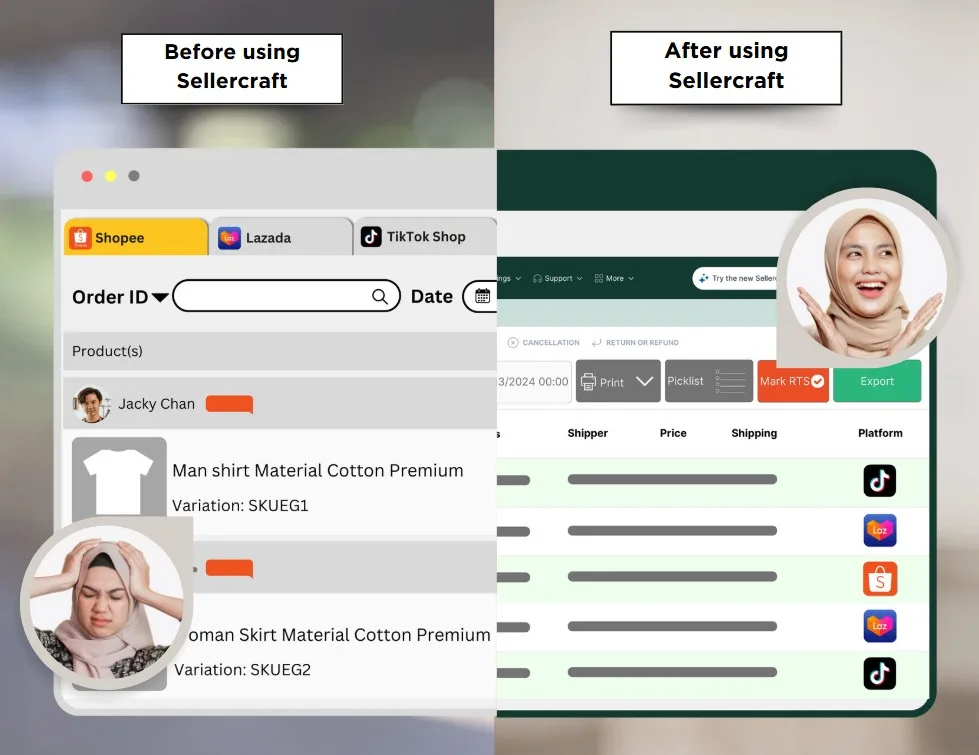Data Integration: The Key to Scaling E-Commerce Success in Malaysia & Singapore
Unlock e-commerce growth in Malaysia & Singapore! Master data integration to crush inventory chaos, boost sales, and personalize shopping. Scale smarter!

In 2023, a family-run batik shop in Penang faced a modern problem. Their handcrafted textiles went viral on TikTok, and orders poured in from their website, Shopee, and Instagram. But within weeks, the owner was drowning: oversold products, delayed shipments, and customers complaining about duplicate promo emails. “We grew too fast,” she told The Star. “I didn’t realize how messy data could ruin us.”
She’s not alone. Malaysia’s e-commerce market grew by 17% in 2022, hitting RM20.3 billion as more businesses go digital, per Statista’s 2023 E-Commerce Outlook. Millions of shoppers browse, click, and buy online every day, and businesses are scrambling to keep up with demand. But rapid growth comes with chaos.
Orders flood in from multiple platforms, inventory systems get tangled, and customers expect seamless experiences. The solution? Data integration.
Think of data integration as the ultimate organizer for your business. It connects every tool, platform, and spreadsheet you use into a single, streamlined system. Instead of drowning in disconnected data, you gain clarity. Let’s explore why this is the backbone of scaling any e-commerce business.
What Is Data Integration?
Data integration is the process of making all your apps, tools, and platforms work together seamlessly. For instance, when a customer buys a product on your website, your inventory system automatically updates, your shipping provider gets notified, and your marketing tool tags the customer for future promotions.
Without integration, you’re manually copying data between systems—like typing the same message into ten different group chats. It’s time-consuming, error-prone, and unsustainable. With integration, everything flows automatically. You see real-time insights, reduce mistakes, and make decisions faster.
Why Scaling E-Commerce in Malaysia & Singapore Is a Battle

Growing an online business isn’t as simple as selling more products or hiring more staff. The real challenge lies in managing complexity. Here’s where most businesses stumble:
The Fragmented Customer Journey
Customers don’t shop in a straight line. They might discover your brand on Instagram, compare prices on a marketplace like Shopee, and finally purchase through your website. If these platforms don’t share data, you’ll miss critical patterns.
For example, a customer might abandon their cart on your site but buy the same product later on a third-party platform. Without integrated data, you’d assume they lost interest—and miss the chance to retarget them effectively.
Inventory Management Mayhem
Storing products in multiple warehouses? Selling across Malaysia and Singapore? If your inventory data isn’t synced in real time, you risk overselling items or shipping delays. Imagine listing a product as “in stock” on your website when it’s actually sold out in your main warehouse. Customers get frustrated, and your reputation takes a hit.
Marketing That Misses the Mark
Running ads for a product that’s out of stock. Sending discount codes for items a customer already bought. These mistakes happen when your marketing tools aren’t connected to your sales and inventory systems. You waste money on irrelevant campaigns and annoy customers.
How Data Integration Turns Chaos into Clarity

Real-Time Inventory Tracking
Data integration ensures your inventory levels update automatically across all platforms. When a product sells on your website, your warehouse management system deducts it from stock immediately. This prevents overselling and helps you restock popular items faster.
Advanced systems even track shipment progress. If a delivery is delayed, you can proactively notify customers and offer solutions—like a discount on their next purchase.
Personalized Customer Experiences
Customers want tailored recommendations, not generic ads. Data integration lets you analyze browsing history, past purchases, and even social media interactions to predict what they’ll buy next.
For example, if a customer frequently buys skincare products, you can send them a promo for a new moisturizer. If they abandon a cart, you can follow up with a gentle reminder or a limited-time discount.
Smarter Marketing Decisions
Integrated data reveals which campaigns actually drive sales. Instead of guessing whether your Instagram ads or email newsletters perform better, you can see precise metrics.
For instance, you might discover that customers in Singapore prefer video ads, while those in Malaysia respond better to text-based promotions. This lets you allocate your budget strategically and avoid wasting money on ineffective tactics.
The Hidden Costs of Ignoring Data Integration
Wasted Time and Energy
Manually entering data into multiple systems eats hours you could spend on strategy or customer service. Studies show small businesses lose dozens of hours weekly on repetitive tasks like updating spreadsheets or reconciling mismatched numbers.
Missed Sales Opportunities
A customer browses hiking gear on your app but leaves without buying. With integrated data, you could send them a targeted email the next day showcasing related products. Without it, that lead vanishes into the void.
Eroded Customer Trust
Inconsistent data leads to mistakes like sending duplicate promo emails or listing out-of-stock items. These errors frustrate customers and damage your brand’s credibility. Over time, shoppers will take their business elsewhere.
How to Integrate Your Data (Without Losing Your Sanity)
Start by Mapping Your Data Flow
Identify every tool and platform your business uses. Ask: Where does customer data come from? Sales platforms? Social media? Email sign-ups? Where does it need to go? Inventory systems? Marketing tools? Shipping providers?
This “map” helps you spot gaps. For example, you might realize your CRM doesn’t receive data from your newest sales channel, leading to incomplete customer profiles.
Choose the Right Integration Method
Three common approaches exist. APIs allow apps to communicate directly. For example, your online store can share sales data with your inventory software in real time. Middleware acts as a bridge between tools that don’t natively integrate. Custom solutions are tailored to complex setups, like businesses operating across multiple countries or niche industries.
Automate Repetitive Tasks
Set rules to automate workflows. For example, when a sale occurs on any platform, update inventory, notify your shipping team, and add the customer to your email list. Automation reduces human error and frees your team to focus on creative tasks.
Test and Refine Continuously
Start small. Connect two tools first—like your website and email marketing software. Monitor for errors, like duplicate entries or delayed updates. Once that runs smoothly, add more connections. Over time, you’ll build a system that grows with your business.
Debunking Common Data Integration Myths
Myth 1: “It’s Only for Big Corporations”
Small businesses often benefit more from data integration. Why? You lack the resources to fix errors or analyze messy data manually. Integration keeps your operations lean and agile, letting you compete with larger players.
Myth 2: “It’s Too Expensive”
Many affordable tools exist, even for startups. Free or low-cost platforms can automate basic tasks like syncing sales data to inventory sheets. As you scale, you can invest in more advanced solutions.
Myth 3: “You Need Coding Skills”
Modern integration tools are user-friendly. Drag-and-drop interfaces and pre-built templates let non-technical users connect apps effortlessly. You don’t need to write a single line of code.
The Future of E-Commerce Runs on Data
Customer expectations are rising. Shoppers want same-day delivery, personalized recommendations, and flawless service. The only way to meet these demands is through data integration.
Businesses that leverage data can predict trends, optimize pricing, and prevent fraud. For example, analyzing purchase patterns might reveal that customers in Kuala Lumpur buy more gadgets during monsoon season. You could stock up in advance and run targeted ads.
Those who ignore data integration will struggle with inefficiencies, errors, and stagnant growth. In a competitive market like Malaysia and Singapore, standing still means falling behind.
How Sellercraft Simplifies Data Integration

If you’re overwhelmed, partnering with experts or specialized solutions can accelerate your progress. This is where Sellercraft steps in—a specialized partner that handles the heavy lifting so you can focus on growing your brand.
Sellercraft offers tailored data integration solutions designed specifically for e-commerce scalability. Our tools act as a bridge between your scattered systems, turning chaos into clarity. For example, we sync real-time sales data from platforms like Shopee and Lazada with your inventory management software, ensuring your stock levels are always accurate. We also connect your customer relationship management (CRM) tools with marketing platforms, enabling personalized campaigns based on purchase history or browsing behavior.
When you sign up for Sellercraft, you get a unified dashboard, which compiles data from every corner of your business—sales, inventory, customer feedback, and logistics—into a single, easy-to-read interface. This means you can track performance trends, spot bottlenecks, and make decisions without jumping between 10 different apps.
For businesses struggling with cross-border complexities, Sellercraft builds custom solutions. Let’s say you’re a Malaysian brand selling in both Malaysia and Singapore. We can integrate tax calculators, currency converters, and shipping rules into your system, automating compliance and reducing errors.
Take Small Steps for a Big Impact
Data integration isn’t about overnight transformation. It’s about making incremental changes that compound over time. Start by syncing two tools this week. Next month, automate a manual process. Gradually, you’ll build a seamless system that scales with your ambitions.
Or, if you want to simplify and speed up the process of scaling your e-commerce, reach out to us today.


Remember: Every major e-commerce success story begins with organized data. Yours could be next.